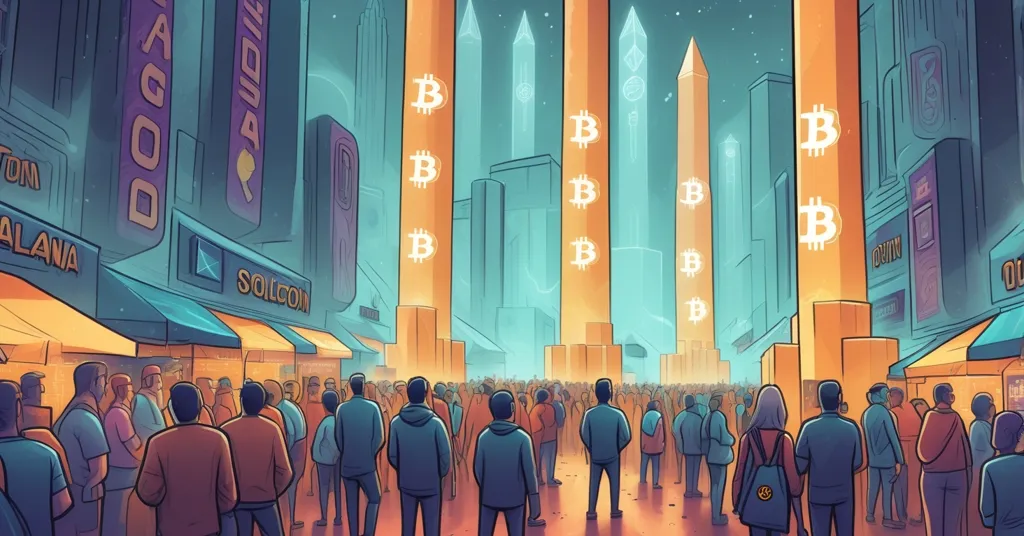MAGACOIN FINANCE Sparks Hype as Bitcoin, Solana Traders Bet Big; Stellar DeFi Future Uncertain

MAGACOIN FINANCE Stirs Hype Among Bitcoin and Solana Traders as Stellar’s DeFi Path Remains Foggy
A fresh contender has emerged in the crypto scene of Q3 2025, and it’s grabbing attention for all sorts of reasons. MAGACOIN FINANCE, a new altcoin fusing meme coin chaos with political flair, is drawing Bitcoin and Solana traders hungry for the next speculative jackpot, while Stellar grapples with an unclear future in decentralized finance despite high-profile partnerships.
- MAGACOIN FINANCE Buzz: A 2025 altcoin with meme appeal, political branding, and governance claims, pulling in serious investor curiosity.
- Stellar’s DeFi Dilemma: Uncertainty clouds its role despite ties with Mastercard and PayPal, redirecting liquidity to newer projects.
- Bitcoin & Solana Power: BTC holds over 65% market share; SOL dominates DeFi with $275B weekly volume, yet traders chase altcoin upside.
MAGACOIN FINANCE: Hype or Hazard?
Let’s cut straight to the chase: MAGACOIN FINANCE is making waves in 2025, but not without a heavy dose of skepticism. This altcoin isn’t just another meme token riding a viral wave; it’s marketed as a blend of internet humor, ideological statement, and community experiment. Its political branding—tied to a culturally charged narrative—gives it a unique edge, tapping into emotions and values that can rally a dedicated following. Think of it as Dogecoin with a political megaphone, harnessing cultural themes to fuel engagement much like SHIB did with memes. But here’s the rub: that same branding could just as easily alienate half its potential audience or attract regulatory heat in a geopolitically tense climate.
What’s got wallets opening is a capped supply designed to curb inflation and create scarcity, paired with audited smart contracts for a layer of trust that’s rare in the lawless corner of crypto where scams outnumber legit projects ten to one. Reports claim every presale stage sold out faster than a Bitcoin ETF launch, hinting at strong market confidence. But let’s slam on the brakes—there’s zero public evidence to verify these sellouts, audits, or even the project’s core team. In a space littered with rug pulls and presale scams, where vague roadmaps and fake news are standard operating procedure, MAGACOIN FINANCE smells of both opportunity and danger. For newcomers, a quick tip: dig into platforms like GitHub for developer transparency, verify audit reports through reputable firms, and check community forums like Reddit for discussions on MAGACOIN hype and scams for red flags. If the devs are ghosts and the promises are vague, run—don’t walk—away from the hype.
Then there’s the governance utility angle. Supposedly, MAGACOIN holders can vote on project decisions, akin to decentralized autonomous organizations (DAOs)—think of DAOs as digital co-ops where token holders steer the ship without a central boss. Sounds empowering, but without clear implementation or transparency, it’s just marketing fluff. Is this a real feature or a shiny wrapper to lure in suckers? Until the project proves its worth, it’s a gamble dressed up in patriotic packaging, and risk-tolerant traders from Bitcoin and Solana circles seem willing to roll the dice for early-stage gains.
Bitcoin’s Unshakable Dominance Under Threat
While altcoins like MAGACOIN FINANCE chase the spotlight, Bitcoin remains the heavyweight champ, boasting over 65% market share in early 2025. With a price around $107,000 (a hypothetical projection based on current trends, mind you), BTC continues to draw record ETF inflows and even whispers of U.S. reserve status in political debates. It’s the gold standard of decentralized money, a middle finger to centralized finance, and a safe harbor for value in a world of fiat uncertainty. Institutional muscle keeps pouring in, solidifying its role as the benchmark for crypto stability, as shown in recent Bitcoin market dominance analysis for 2025.
But don’t get too cozy. Macro headwinds are brewing, and they’re not small potatoes. Recent tariffs slapped on $1.3 trillion worth of goods from Canada, Mexico, and China by the Trump administration are rattling risk-on assets like Bitcoin. These aren’t just political stunts; they’re rooted in deep trade deficit worries, and analysts warn of prolonged volatility. Macro trader Geo Chen of Fidenza Macro has pointed out that markets might take “days or weeks” to digest the full impact, especially if retaliation escalates. Another trader noted bluntly that these moves “don’t feel temporary.” Beyond price swings, such trade wars could shrink retail investor budgets or spook institutional allocations into crypto, threatening Bitcoin’s momentum. Historically, BTC has weathered economic storms, but this kind of uncertainty pushes some traders to speculative altcoins for outsized returns, even if it fuels the scam cycle delaying mainstream blockchain adoption.
Solana’s DeFi Surge: Too Good to Last?
While Bitcoin grapples with external pressures, Solana is carving a blazing path in decentralized finance, or DeFi—think of it as a bank you run on your computer, no middleman required, handling lending, borrowing, and trading via smart contracts. These are self-executing agreements on the blockchain that cut out intermediaries, automating trust with code. Solana’s speed and dirt-cheap transaction costs make it a darling for DeFi developers, racking up a staggering $275 billion in weekly volumes and a 156% year-to-date surge in stablecoin activity, according to recent Solana DeFi volume data for 2025. That’s like the Usain Bolt of blockchains—blazing fast and hard to ignore, delivering cheaper, quicker trades for users. Add a newly launched U.S. ETF for SOL, and it’s cementing its spot as a DeFi juggernaut.
Yet, even champions stumble under pressure. Solana faces price resistance—those pesky levels where selling pressure halts upward climbs—and the same macro volatility hitting Bitcoin could dent its momentum. If trade tensions tighten wallets globally, DeFi volumes might take a hit as users pull back from risk. Still, for Solana traders, the lure of projects like MAGACOIN FINANCE isn’t just diversification; it’s the thrill of catching a rocket before liftoff, even if there’s a decent chance it explodes on the pad. The question is whether Solana’s DeFi dominance can weather broader market storms, or if cracks are starting to show, as explored in this Solana DeFi growth and risks analysis for 2025.
Stellar at a Crossroads
Stellar (XLM), once a darling for cross-border payments, finds itself in a bit of an identity crisis in 2025. On paper, it’s got the goods: a partnership with Mastercard for its Crypto Credential framework to verify transactions, and plans to launch PayPal’s PYUSD stablecoin—a crypto pegged to the U.S. dollar for low volatility, often used in DeFi or payments. If buying demand holds through Q3 and Q4, some speculate XLM could hit a $1 target. But despite smart contract upgrades via Protocol 23, a network update meant to boost functionality like better DeFi integration, Stellar’s role in this sector remains murky, as detailed in this expert analysis on Stellar’s DeFi adoption challenges.
Unlike Solana or Ethereum, Stellar hasn’t captured key DeFi use cases like yield farming—earning rewards by lending crypto—or dominating decentralized exchanges (DEXs) for peer-to-peer trading. Liquidity that might have flowed its way is trickling to flashier, riskier bets like MAGACOIN FINANCE. The upcoming Q4 review in February 2025 could be a make-or-break moment. Will Stellar pivot into a DeFi contender with new initiatives, or remain a niche player in payments? Until clarity emerges, the uncertainty gives smaller altcoins room to steal the stage, even if they’re long shots.
Political Branding: Rocket Fuel or Kryptonite?
Let’s zero in on MAGACOIN FINANCE’s political branding—a feature that’s either the most American crypto since blockchain apple pie, or a regulatory landmine waiting to detonate. On one hand, tying a token to a cultural or ideological narrative can supercharge community engagement. It’s a playbook straight out of meme coin history: rally a tribe around a shared joke or cause, and watch the buys pour in. MAGACOIN’s narrative offers that viral edge, pulling in investors who vibe with its message, as covered in this report on MAGACOIN FINANCE drawing Solana and Bitcoin traders.
On the flip side, it’s a lightning rod. In a world of trade wars and polarized politics, slapping a politically charged label on a cryptocurrency risks alienating half the market and inviting scrutiny from regulators already itching to crack down. Compare this to Bitcoin or Solana, where the focus stays on tech and utility, not ideology. Sure, MAGACOIN’s branding might drive early hype, but it could just as easily trigger a backlash or legal headaches down the line. Traders from BTC and SOL camps seem willing to bet on the upside, but at what cost? It’s a tightrope walk between viral growth and catastrophic fallout, and some are questioning if MAGACOIN FINANCE is a legitimate investment. Additionally, community feedback raises serious scam concerns about MAGACOIN FINANCE in 2025 that shouldn’t be ignored.
What’s Next for Crypto in 2025?
Stepping back, the crypto market in 2025 is a wild cocktail of maturity and madness. Bitcoin and Solana stand as pillars of relative stability, backed by institutional clout and proven use cases, though not immune to macro shocks like tariffs shaking risk assets. Stellar’s crossroads moment adds intrigue—its next moves could disrupt the altcoin hype cycle or confirm its fade into obscurity. Then there’s MAGACOIN FINANCE, the wildcard of the year, embodying the speculative fever that still grips this space. If it proves legit, it could redefine how narratives drive crypto adoption. If not, it’s another cautionary tale in a long list of scams.
Macro risks like trade tensions loom large, potentially curbing retail and institutional investment while fueling volatility. Yet, the promise of decentralization, privacy, and disrupting the financial status quo keeps the flame alive. Whether you’re a Bitcoin maximalist or an altcoin adventurer, the road ahead demands sharp eyes and steel nerves. The revolution rolls on—just don’t bet the farm without doing your homework.
Key Takeaways and Questions for Crypto Enthusiasts
- Is MAGACOIN FINANCE a good investment in 2025?
It’s a high-risk, high-reward play with meme appeal, political branding, and governance claims, but unverified presale success and lack of transparency scream caution—do your due diligence before jumping in. - Why are Bitcoin and Solana traders eyeing MAGACOIN FINANCE?
Despite BTC’s 65% market dominance and SOL’s DeFi surge, traders seek early-stage altcoin upside for massive gains, balancing the safety of established assets with speculative bets. - Why is Stellar struggling with DeFi adoption?
Even with Mastercard and PayPal partnerships, Stellar’s unclear strategy and failure to dominate DeFi niches like yield farming under Protocol 23 upgrades push liquidity to riskier projects. - How do macro factors like tariffs affect crypto markets?
Trump’s tariffs on $1.3 trillion in goods create volatility for risk-on assets like Bitcoin, potentially shrinking investor budgets and driving speculative plays while threatening overall stability. - Is political branding in crypto an asset or a risk?
It’s a powerful tool for viral growth and community building, as with MAGACOIN FINANCE, but a massive risk due to polarization and regulatory scrutiny in a tense global environment. - What’s the future of Bitcoin’s dominance in 2025?
With ETF inflows and reserve talks, BTC remains the decentralized gold standard, but macro headwinds like trade wars could test its resilience, pushing some toward altcoin gambles.



